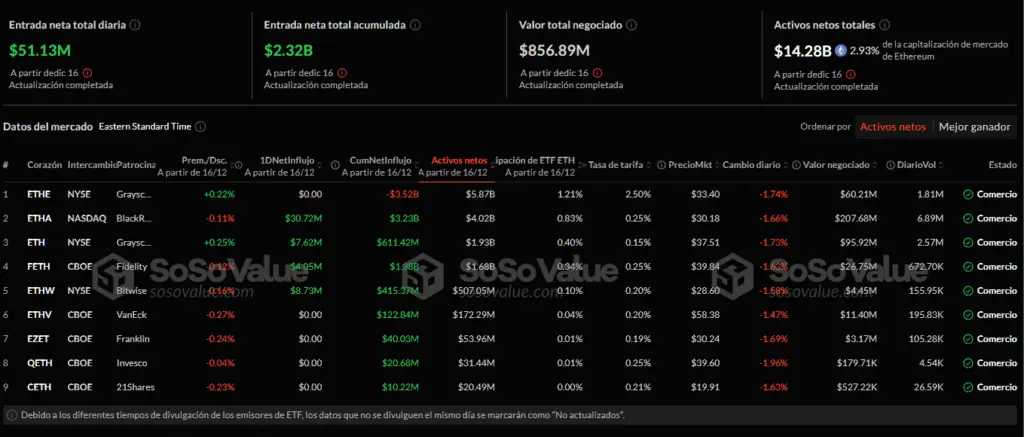
Analysts are looking to the possibility that the new Trump administration will lift the staking restrictions on Ethereum ETFs, thereby triggering institutional interest in these financial instruments.
Ethereum ETFs have come to market with a very attractive proposition, which goes beyond simple exposure to the asset's price. After all, these funds allow investors to participate in the growth of Ethereum, the second largest cryptocurrency by market capitalization, in a more regulated and accessible way. Having started quite positively, but with an overall performance so far well below expectations, Ethereum ETFs have been in the eye of the storm when compared to Bitcoin ETFs. However, many analysts still maintain that these instruments are very promising, and time may end up proving them right.
But What Makes Ethereum ETFs So Promising? The answer lies in a key feature of the Ethereum network: the possibility of staking. Recall that staking is a process where ETH holders can lock their assets on the network and participate in the validation of transactions. In return, they receive rewards in the form of additional ETH. Now, At the moment, current Ethereum ETFs do not allow staking; however, this could change with the arrival of the Trump administration., which allows investors to obtain an additional layer of profitability, beyond the mere appreciation of the asset's price. This possibility of obtaining returns through staking is a key differentiating factor compared to Bitcoin ETFs, which do not offer this functionality.
As an example, if an ETF allows its investors to stake their ETH, they could earn an additional return of 3-5% per year. In a low interest rate environment, this additional return is very attractive for institutional investors looking to maximize their profits without taking unnecessary risks.
Why Ethereum ETFs Could Outperform Bitcoin Ones
Staking is a key competitive advantage for Ethereum ETFs. While Bitcoin ETFs offer exposure to the most popular cryptocurrency, they do not offer their investors the opportunity to earn passive returns through staking. This difference is crucial, especially for institutional investors who are used to seeking additional returns on their investments.
Furthermore, let’s remember that the Ethereum network also has a technological advantage. Ethereum is a versatile platform for decentralized applications (dApps) and smart contracts, which gives it greater growth potential in the long term. The demand for these applications and the adoption of Ethereum in various sectors are creating a robust ecosystem that could boost the demand and value of ETH, and by extension, the attractiveness of ETFs.
On the other hand, since Donald Trump became president of the United States, there has been a notable change in market sentiment towards cryptocurrencies.
Expert Analysis: The Future of Ethereum ETFs is Bright
Given this outlook, several analyst firms have expressed optimism about the future of Ethereum ETFs. Players such as Robinson Burkey and Bernstein have noted that favorable regulation under the Trump administration could make ETH staking in ETFs a reality by 2025. However, they have also warned that the mechanisms for distributing these rewards will need to be clear and consistent to comply with institutions’ risk management rules and standards.
In light of this, Ruslan Lienkha, Head of Markets at YouHodler, has also mentioned that this change would allow investors to earn returns on their ETH holdings, opening up new opportunities for institutional investors seeking passive income. Meanwhile, Julio Moreno, Head of Research at CryptoQuant, has highlighted that staking could become a major driver of inflows into Ethereum ETFs, reducing the circulating supply and increasing the attractiveness of ETH as a yield-generating investment.
Even Offchain Labs CEO Steven Goldfeder has argued that Ethereum ETFs that do not offer staking are at a disadvantage, as the staking mechanism adds crucial value to the digital asset. In short, the consensus among experts is that, in a proper regulatory environment, staking could make Ethereum ETFs a more attractive option than Bitcoin ETFs.
A look at the past and the future
And at this point it is worth remembering that since their launch, Ethereum ETFs have shown steady growth, although they have faced challenges such as the volatility inherent to the cryptocurrency market and regulatory uncertainties. Initially, the lack of regulatory clarity on staking limited the adoption of these ETFs. However, now with a more favorable outlook, an increase in demand and capital inflows is observed.
The data from SosoValue The data show that Ethereum-based funds have seen a strong rise, reaching a market cap of over $14,2 billion. This growth, despite the absence of staking in US ETFs, is a clear sign of growing interest in ETH. Despite this, Ethereum ETFs are showing a poor performance compared to Bitcoin ETFs. To the point where the entire Ethereum ETF cap is only 10% of the cap we see in its Bitcoin counterpart.

Nevertheless, the recovery of Ethereum ETFs is good news and an opportunity that many have begun to take advantage of. An example of this is the acquisition of Attestant Limited by Bitwise Asset Management. This acquisition, which included $3,7 billion in ETH assets, reinforces Bitwise's commitment to the future of Ethereum and positions Bitwise as a major player that can offer safe and efficient staking services to its investors through ETFs.
Market performance: Ethereum ahead?
If this happens, the reality of the markets where Ethereum is active would be rewritten. Let us remember that if we compare the market performance of Ethereum ETFs with that of Bitcoin, we see a growing parity in momentum, but not in their capitalization. This can change completely with the unlocking of staking, which will also strongly influence the price of ETH. Above all, because the price of ETH has shown a strong correlation with the inflows and outflows of ETFs, which indicates that institutional activity is increasingly influencing the market.
All of this suggests that if Ethereum ETFs manage to incorporate staking, we could see an acceleration in the difference in returns. Especially for investors looking to combine the security of ETFs with the passive returns of staking, which could lead them to opt for ETH ETFs instead of BTC ones.
But for this, only one thing is missing in the whole puzzle: the regulatory unblocking, and everything seems to indicate that 2025, may bring us surprises in that regard.


